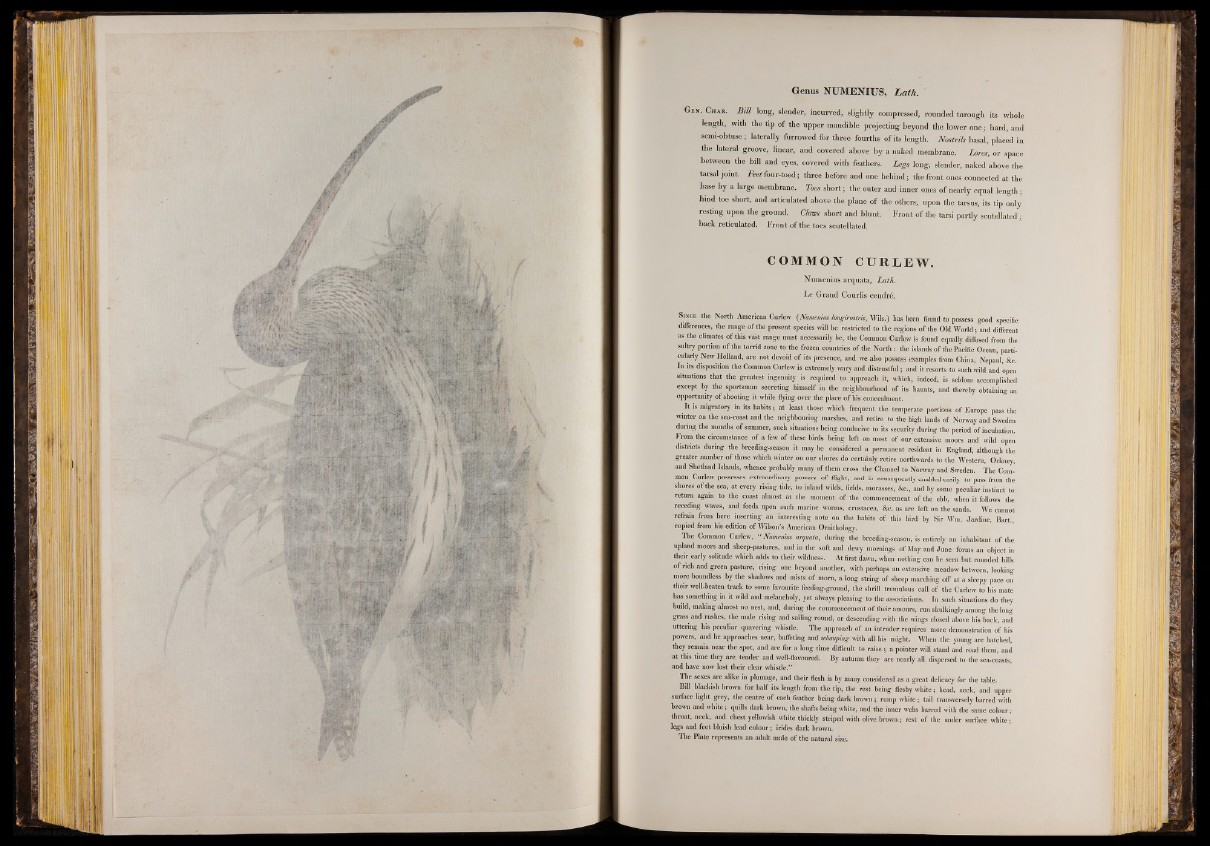
Genus NUMENIUS, Lath.
Gen. Char. B ill long, slender, incurved, slightly compressed, rounded tnrough its whole
length, with the tip of the upper mandible projecting beyond the lower one; hard, and
semi-obtuse ; laterally furrowed for three fourths of its length. Nostrils basal, placed in
the lateral groove, linear, and covered above by a naked membrane. Lores, or space
between the bill and eyes, covered with feathers. 'Legs long, slender, naked above the
tarsal joint. Feet four-toed; three before and one behind; the front ones connected at the
base by a large membrane. Toes short; the outer and inner ones of nearly ecpial length;
hind toe short, and articulated above the plane of the others, upon the tarsus, its tip only
resting upon the ground. Glams short and blunt. Front of the tarsi partly scutellated;
back reticulated. Front of the toes scutellated.
COMMON CURLEW.
Numenius arquata, Lath.
Le Grand Courlis cendré.
S in c e the North American Curlew (Numenius Imgirostris. Wils.) has been found to possess good specific
differences, the range o f the present species will be restricted to the regions o f the Old World; and different
as the climates o f this vast range must necessarily be, the Common Curlew is found equally diffused from the
sultry portion o f the torrid zone to the frozen countries o f the North : the islands o f the Pacific Ocean, particularly
New Holland, are not devoid o f its presence, and we also possess examples from China, Nepaul, &c.
In its disposition the Common Curlew is extremely wary and distrustful; and It resorts to such wild and open
situations that the greatest ingenuity is required to approach it, which, indeed, is seldom accomplished
except by the sportsman secreting himself in the neighbourhood o f its haunts, and thereby obtaining an
opportunity o f shooting it while flying over the place o f his concealment.
It is migratory in its habits; at least those which frequent the temperate portions of Europe pass the
winter on the sea^oast and the neighbouring marshes, and retire to the high lands o f Norway and Sweden
during the months o f summer, such situations being conducive to its security during the period o f incubation.
From the circumstance o f a few o f these birds being left on most of our extensive moors and wild open
districts during the breeding-season it may be considered a permanent resident in England, although the
greater number o f those which winter on our shores do certainly retire northwards to the Western, Orkney,
and Shetland Islands, whence probably many o f them cross the Channel to Norway and Sweden. The Common
Curlew possesses extraordinary powers o f flight, and is consequently enabled easily to pass from the
shores o f the sea, at every rising tide, to inland wilds, fields, morasses, &c., and by some peculiar instinct to
return again to the coast almost at the moment o f the commencement o f the ebb, when it follows the
receding waves, and feeds upon such marine worms, Crustacea, &c. as are left on the sands. We cannot
•refrain from here inserting an interesting note on the habits o f this bird by Sir Wm. Jardine, Bart.,
copied from his edition o f Wilson’s American Ornithology.
The Common Curlew, ‘ ‘ Numenius arquata, during the breeding-season, is entirely an inhabitant o f the
upland moors and sheep-pastures, and in the soft and dewy mornings of May and June forms an object in
their early solitude which adds to their wildness. At first dawn, when nothing can be seen but rounded hills
o f rich and green pasture, rising one beyond another, with perhaps an extensive meadow between, looking
more boundless by the shadows and mists o f morn, a long string o f sheep marching off at a sleepy pace on
their well-beaten track to some favourite feeding-ground, the shrill tremulous call o f the Curlew to his mate
has something in it wild and melancholy, yet always pleasing to the associations. In such situations do they
build, making almost no nest, and, during the commencement o f their amours, run skulkingly among the long
grass and rushes, the male rising and sailing round, or descending with the wings closed above his back, and
uttering his peculiar quavering whistle. The approach o f an intruder requires more demonstration o f his
powers, and he approaches near, buffeting and whauping with all his might. When the young are hatched,
they remain near the spot, and are for a long time difficult to raise; a pointer will stand and road them, and
at this time they are tender and well-flavoured. B y autumn they are nearly all dispersed to the sea-coasts,
and have now lost their clear whistle.”
The sexes are alike in plumage, and their flesh is by many considered as a great delicacy for the table.
BiH blackish brown for half its length from the tip, the rest being fleshy white; head, neck, and upper
surface light grey, the centre o f each feather being dark brown; rump white; tail transversely barred with
brown and white; quills dark brown, the shafts being white, and the inner webs barred with the same colour;
throat, neck, and chest yellowish white thickly striped with olive brown; rest o f the under surface white;
legs and feet bluish lead colour; ¡rides dark brown.
The Plate represents an adult male o f the natural size.